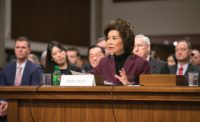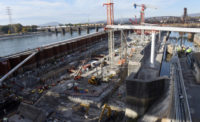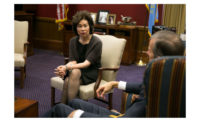The outlines of President Trump’s promised $1-trillion, 10-year infrastructure initiative are coming into clearer focus. Transportation Secretary Elaine Chao has provided more information about the plan, saying states and localities that bring their own funding and financing to the table will get priority in receiving the additional federal dollars the proposal will contain.
Speaking at a May 15 Infrastructure Week kickoff event at the U.S. Chamber of Commerce in Washington, D.C., Chao also confirmed earlier administration comments that the package will propose $200 billion in direct federal funding, which it hopes will trigger another $800 billion in private financing. She also said officials "in coming weeks" will unveil the "vision of what the infrastructure plan wll look like."
John Porcari, president of advisory services for WSP USA, told ENR at the conference, “It’s encouraging that the secretary is talking about a combination of things in an infrastructure package, including new [federal] funding, additional funding, which is an essential element for any multi-year, sustained infrastructure program.“
Porcari, a former deputy transportation secretary in the Obama administration, says, “We need to build on the stability of the FAST Act, and ramp it up. And having a sustained increased federal government financial contribution will be a very important signal to projects around the country.” (He was referring to the five-year surface transportation authorization measure enacted last December.)
Terry O’Sullivan, general president of the Laborers’ International Union of North America, says of the upcoming Trump plan, “We’re extremely interested to see what that looks like. Obviously, we’re a pro-infrastructure union.”
O’Sullivan says, “The good news is we’re talking about a lot of money.” He adds that the union has “concerns” about what the funding sources will be and what labor protections the plan may include.
He also says, “In general…we like more federal spending than private” as a percentage of the package. But he adds, “We’re certainly not against private.”
Chao said that the Office of Management and Budget is “identifying offsets” to that $200 billion, “to avoid saddling future generations with more debt.” She didn’t specify what the offsets would be.
Chao said that the administration’s plan may go beyond such infrastructure categories highways, transit, rail, inland waterways and ports to also include energy, water, broadband and veterans’ hospitals.
She reiterated earlier statements that the proposal will include steps aimed at accelerating project approvals and permitting.
Priority treatment
Chao went beyond previous comments, to say that the administration wants to use the new $200 billion in federal infrastructure funds to augment, not replace, state and other nonfederal funds.
Observing that the federal government accounts for less than 20% of all infrastructure spending, Chao said, “This administration wants to retain the primacy of state and local spending and use federal funding as leverage to increase the total amount of funding available for infrastructure.”
She said that states and localities that have their own funds or other nonfederal financing lined up for infrastructure projects “will be given higher priority access to new federal funds.”
Chao added, “The goal is to use federal funding as an incentive to get projects underway and built more quickly, with greater participation by state, local and private partners.”
Porcari, also a former head of the Maryland DOT, says ,“Most of the increase in funding in the transportation [sector] has actually been at the state and local level.”
He adds, “The states and cities have stepped up to the plate in a big way, through self-help initiatives,” such as bond measures, and motor-fuel, property and sales tax increases. Porcari points to the Seattle area’s approval of $54 billion in sales and excise-tax increases for its Sound Transit system.
Porcari says, “If part of Secretary Chao’s message is the federal dollars need to be the last dollars in, I think that’s happening.”
Chao said the infrastructure plan also will include “a few special projects” that would receive only direct federal funds. “Candidates for this special category may include projects that have the potential to significantly increase GDP growth or to lift the American spirit,” Chao said.
She said, “This administration is committed to an infrastructure package that addresses the needs of the entire country, urban and rural." Chao acknowledged that toll highways may be successful in urban regions but not in rural areas, which could lack enough traffic volume to generate needed revenue.
Chao suggested that "availability payments" may be an alternative-financing tool. Under that option, government agencies sign contracts with private firms to build, operate and maintain a highway, for example. The agency agrees to pay the contractor installments over a period of time for those services, if it meets performance requirements.
Workforce issues
Chao also said that as the administration focuses on upgrading infrastructure it also is “looking at ways to revitalize our country’s workforce.”
Chao, secretary of Labor from 2001 to 2009, added, “Far too many people are being left behind because they are not equipped with the skills in demand in our rapidly changing economy.” She citied community college programs, vocational training for high school students and “excellent training programs” provided by labor unions and government agencies." Chao also underscored that employers must be involved in vocational and skills training.
LIUNA's O'Sullivan says that though there are labor shortages in some localities, construction unions are "still recoveing from the recession" and have benefited from the FAST Act and projects in the energy sector.
O'Sullivan says that as the debate progresses on how to fund and rebuild U.S. infrastructure, "At the end of the day, we believe it would be a golden opportunity missed to not train and recruit the workforce of tomorrow. And you only do that when there are 'high-road' jobs."






Post a comment to this article
Report Abusive Comment